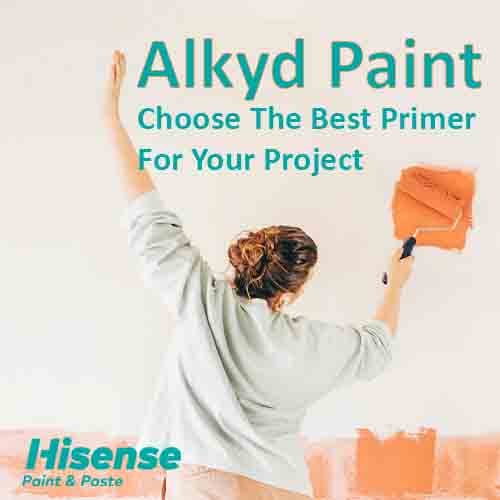What Is Alkyd Paint?
Alkyd paint is a type of enamel finish that is similar in consistency to oil paints, but it contains no oil. Instead, it is typically formed by an alkyd resin dissolved in a solvent.
These paints typically have thinners made from either alcohol or mineral spirits, which govern how much the paint flows and how quickly it dries.
Conventional alkyd paints dry by solvent evaporation and cure by oxidation in approximately five days to a hard, glossy finish that is unmatched by latex.
There are also waterborne alkyd paints available that offer the benefits of alkyd paints with the added advantage of easy cleanup with soap and water.
How is alkyd paint made?
Alkyd paint is made by combining an oil-modified polyester to form the coating film, a solvent such as hexane or mineral spirits to aid in application, metal naphthenates to catalyze the drying reaction, and pigment to provide color and hide the coated surface.
The oil content of the formulation can vary.
The alkyd resin, which is a complex oil-modified polyester that serves as the film-forming agent in some paints and clear coatings, is typically based on a polymerization reaction between an alcohol, such as glycerol, and a dicarboxylic acid or its anhydride.
The reaction occurs in the presence of oxygen from the surrounding air as it dries, yielding a tack-free film.
Waterborne alkyd paints are also available, which use water as a solvent instead of oil or mineral spirits.
What are the advantages of using alkyd paint?
Alkyd paint has several advantages:
- It dries much faster than oil paints, but slower than acrylics, which means that the paint remains workable for many hours, depending on how thickly it is applied.
- They are water-resistant and easy to clean using water, making them environmentally friendly and less toxic.
- The binder in alkyd paint is a strong resin, making it very resistant to damage, which makes it a good paint for high-traffic areas of a home such as hallways, and for use in the kitchen or bathroom.
- Alkyd resin paints and varnishes are durable, high-quality finishes primarily used in exterior coating applications to protect a surface.
- Alkyd coatings are resistant to moisture, non-flammable, and prevent corrosion for up to five years, making them ideal for marine or underwater applications.
What is the difference between alkyd and oil-based paint?
The main difference between alkyd and oil-based paint is that alkyd paint is a synthetic resin made from a polymerization reaction between an alcohol and a dicarboxylic acid or its anhydride, while oil-based paint is made from natural oils such as linseed oil.
Alkyd paint is also known as oil-based paint, but it contains no oil.
Alkyd paint is typically more brittle than latex paint and is more prone to cracking on an exterior surface such as wood trim or doors.
Alkyd paint is an oil/solvent-based paint, while acrylic is a water-based paint. Alkyd paint takes less time to dry than conventional oil paint.
Can alkyd and oil-based paints be used interchangeably?
What are the advantages of using alkyd paints over oil paints?
Alkyd paints dry much faster than oils, but slower than acrylics, and the paint remains workable (wet) for many hours, depending on how thickly it is applied.
Alkyd paints are durable and resistant to wear and tear, making them widely preferred for high-traffic areas in a home or commercial building.
Alkyd paints are fully compatible with oil paints, and they can be used interchangeably with traditional oils and their related products such as turpentine, mineral spirits, and varnishes.
Alkyd paints combine well with conventional oil paints, and they can make an excellent base for oil paint.
However, alkyd paints are more brittle than latex paints and are more prone to cracking on an exterior surface such as wood trim or doors that will expand and contract with the outside temperature.
What are the main components of alkyd paint?
What is the role of metal naphthenates in alkyd paint?
Metal naphthenates play the role of additive driers in alkyd paints, increasing the rate of drying of the applied paint on the surface.
A typical alkyd paint consists of oil-modified polyester to form the coating film, a solvent such as hexane or mineral spirits to aid in application, metal naphthenates to catalyze the drying reaction, and pigment to provide color and hide the coated surface.
Metal naphthenates are industrially useful and include those of aluminum, barium, calcium, cobalt, copper, iron, lead, magnesium, manganese, nickel, potassium, vanadium, zinc, and zirconium.
When added to alkyd-based paints, metal carboxylates markedly reduce the drying times. Cobalt soaps and alternative alkyd curing catalysts are also denoted as paint-drying agents.
We produce the best types of alkyd primers at Aref Chemical. Our products are exported all over the world.
Compare Hisense alkyd primer prices with similar products from other brands.
Contact us for more information and free advice on choosing the right color for your project.
Our colleagues will answer you as soon as possible




24 Responses
Is alkyd paint suitable for home external walls?
you can use epoxy paints for external parts of your home
good job.
thanks dear
https://daroosf.com/%DA%A9%D8%A7%D9%87%D8%B4-%D8%A7%D8%B4%D8%AA%D9%87%D8%A7/
Thank you
https://qomtamirat.com/
It was a very interesting
thanks
https://tavatranslation.com/%da%a9%d8%a7%d8%b1-%d8%af%d8%b1-%d9%81%d8%b1%d8%a7%d9%86%d8%b3%d9%87/
really good
https://behdama.com/%da%af%db%8c%d8%ac-%d9%81%d8%b4%d8%a7%d8%b1/
i love alkyd
https://daroosf.com/%D9%85%DA%A9%D9%85%D9%84-%D8%A8%DB%8C%D9%88%D8%AA%DB%8C%D9%86/
its beautifull
https://behdama.com/%d8%a8%d9%88%d8%b3%d8%aa%d8%b1-%d9%be%d9%85%d9%be/
great
https://behdama.com/%d9%82%d8%b7%d8%b9%d8%a7%d8%aa-%db%8c%d8%af%da%a9%db%8c-%d9%be%d9%85%d9%be/
oh yes
https://daroosf.com/%D9%88%DB%8C%D8%AA%D8%A7%D9%85%DB%8C%D9%86-%D8%AF%DB%8C-%D8%AF%D8%B1-%DA%A9%D9%88%D8%AF%DA%A9%D8%A7%D9%86/
👌👌👌
👍👍👍👍
🙏🙏🙏
I love Alkyd Paint
🤩🤩🤩🤩🤩🤩
https://arefchemical.ir/%D9%BE%D9%84%DB%8C-%D8%A7%D9%88%D8%B1%D8%AA%D8%A7%D9%86/
https://qomtamirat.com/
Alkyd paint is a type of enamel finish
Best wishes
Alkyd paint is a type of oil-based paint made from alkyd resins, which are synthetic resins derived from polyesters and oils.
It is known for its durability, smooth finish, and good adhesion properties.
Alkyd paints dry faster than traditional oil paints and are commonly used for interior and exterior surfaces such as wood, metal, and furniture.
They offer a glossy finish and are resistant to wear, making them suitable for areas that require a tough, long-lasting coating.
https://arefchemical.ir/%d8%b1%d9%86%da%af-%d8%a7%d8%b3%d8%a8%d8%a7%d8%a8-%d8%a8%d8%a7%d8%b2%db%8c/
Thank you